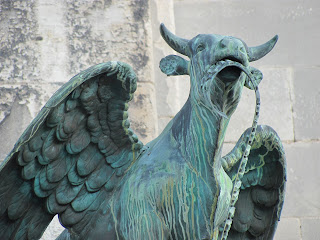 |
| Vase aux hirondelles 1897 |
Audrey : Apparently Nancy's Museum of Fine Arts is one of the oldest museums in France. It is in one of the lovely buildings around the edge of the Place Stanislas. But more about that in another post - this one is all about their wonderful collection of Daum Glass.
Lillian : The Daum Studio is still making beautiful things from glass, and is still based in Nancy. The company was founded in 1878 by Jean Daum and his sons Auguste and Antonin were very active in the Art Nouveau movement and l'Ecole de Nancy.
Audrey : That lovely tall vase has sweet little birdies flying around it - we call those birds Swallows, the French name is l'hirondelle - and you don't pronounce the H.
Lillian : I'll attempt to translate the label for this vase - "blown glass mold, acid etched, enhanced with painting in enamel and gold".
 Audrey : That sounds very complicated and extremely clever. Let's see more lovely Art Nouveau glass vases - this one with wasps and daisies is similar in shape and colour to the one with the birdies.
Audrey : That sounds very complicated and extremely clever. Let's see more lovely Art Nouveau glass vases - this one with wasps and daisies is similar in shape and colour to the one with the birdies.
Lillian : We forgot to note what the label said about this dragonfly vase - but the body of the dragonfly looks as if it were applied, and that mottled, dappled look is usually made by sprinkling powdered material onto the hot glass.
Audrey : I've looked up the French word for the dragonfly - la libellule. Those Art Nouveau artists liked their insects, like this cicada or la cigale.
 |
| Cruche aux épis de blé et à la cigale 1905 |
Lillian : That beautiful ewer made us think of the Summer time; with its ears of wheat, delphiniums, poppies and that blue cicada. From the label ... "mold blown glass, multilayer, acid etched, painting with enamel, enhanced with gold and applications".
Audrey : Multilayer?
 Lillian : Hmm, we'll I'm no expert but sometimes they used several layers of glass in different colours and then they could etch back to reveal the colours underneath.
Lillian : Hmm, we'll I'm no expert but sometimes they used several layers of glass in different colours and then they could etch back to reveal the colours underneath. I think this vase with narcissus is made with multiple layers of glass that were then etched.
Perhaps this tiger-lily vase too ...

The Daum brothers were very clever - they won a 'Grand Prix' at l'Exposition universelle de Paris, 1900. They also collaborated with, and employed other talented artists including Jacques Gruber, Henri Bergé and Amalric Walter.
Amalric Walter is most associated with the pâte de verre (glass paste) process, a revival of an ancient Egyptian technique. Daum still use pâte de verre to make some of their pieces.
Audrey : That's a bit mind-boggling - using such an ancient technique ...
Lillian : Well, when you think about it, making glass is basically the same today as it was in ancient times ... you take silica (quartz sand), add a few things to it such as lime (from limestone) and potash and then you super-heat it until it melts. The Alsace/Lorraine region has produced glass-ware for centuries - perhaps because the area had (still has) plentiful forests, water and very white (so not many impurities) limestone and sand. Baccarat crystal is another glass-maker still in production and Baccarat is just to the South-East of Lorraine.
Let's see more flowers - tulips,
Crocuses and Cœur de Jeannette ...
 |
| Vase aux Cœur de Jeannette 1910 |
Audrey : Oh! that's the flower that we found in Avallon
- we hadn't seen it before. The English call this flower 'Dutchman's
trousers' but I think I prefer the name - Heart of Jeannette.
Audrey : This was my favourite vase - Red Poppies. (you can see the other side in the photo of the Tiger-lily vase above)
 |
| Vase aux pavots rouges 1923 |
Audrey : Excuse me - you said it was "hammered" ? But this is glass, you can't go about hitting beautiful glass vases with a hammer!
Lillian : Well, perhaps the glass is still hot and not quite hardened when they do it ... if you look closely there is a dimpled effect in the glass.
Audrey : I wonder how many lovely things didn't quite make it through all the processes and techniques they used in order to make one vase.
 Lillian : Well, here are some examples of another technique that the Daum Frères used to great effect - application of glass 'bubbles' and 'dribbles'.
Lillian : Well, here are some examples of another technique that the Daum Frères used to great effect - application of glass 'bubbles' and 'dribbles'.Audrey : Very different styles there - the 'grape' vase is earlier than the others.
Lillian : Yes - and here are some very Art Deco pieces ...

 |
| Lampe rectangulaire 1930 |
Audrey : That yellow looks almost edible.
Lillian : The colour, clarity and sparkle of this mid-century vase was amazing.

Audrey : This bowl is quite recent - 1987 - and the cactus (it looks like prickly pear Opuntia) is made with the pâte de verre technique.

Lillian : Our last photo for this post is a close up of an Art Nouveau, bowl. Beautifully decorated with toadstools.
Audrey : In our next post we'll be exploring some of the other things in Nancy's Musée des Beaux-Arts.






























